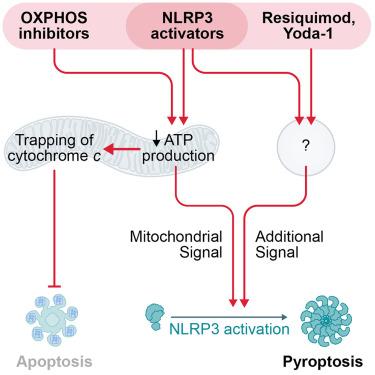Our official English website, www.x-mol.net, welcomes your
feedback! (Note: you will need to create a separate account there.)
Acute suppression of mitochondrial ATP production prevents apoptosis and provides an essential signal for NLRP3 inflammasome activation
Immunity ( IF 25.5 ) Pub Date : 2024-11-20 , DOI: 10.1016/j.immuni.2024.10.012 Benedikt S. Saller, Svenja Wöhrle, Larissa Fischer, Clara Dufossez, Isabella L. Ingerl, Susanne Kessler, Maria Mateo-Tortola, Oliver Gorka, Felix Lange, Yurong Cheng, Emilia Neuwirt, Adinarayana Marada, Christoph Koentges, Chiara Urban, Philipp Aktories, Peter Reuther, Sebastian Giese, Susanne Kirschnek, Carolin Mayer, Johannes Pilic, Olaf Groß
Immunity ( IF 25.5 ) Pub Date : 2024-11-20 , DOI: 10.1016/j.immuni.2024.10.012 Benedikt S. Saller, Svenja Wöhrle, Larissa Fischer, Clara Dufossez, Isabella L. Ingerl, Susanne Kessler, Maria Mateo-Tortola, Oliver Gorka, Felix Lange, Yurong Cheng, Emilia Neuwirt, Adinarayana Marada, Christoph Koentges, Chiara Urban, Philipp Aktories, Peter Reuther, Sebastian Giese, Susanne Kirschnek, Carolin Mayer, Johannes Pilic, Olaf Groß

|
How mitochondria reconcile roles in functionally divergent cell death pathways of apoptosis and NLRP3 inflammasome-mediated pyroptosis remains elusive, as is their precise role in NLRP3 activation and the evolutionarily conserved physiological function of NLRP3. Here, we have shown that when cells were challenged simultaneously, apoptosis was inhibited and NLRP3 activation prevailed. Apoptosis inhibition by structurally diverse NLRP3 activators, including nigericin, imiquimod, extracellular ATP, particles, and viruses, was not a consequence of inflammasome activation but rather of their effects on mitochondria. NLRP3 activators turned out as oxidative phosphorylation (OXPHOS) inhibitors, which we found to disrupt mitochondrial cristae architecture, leading to trapping of cytochrome c. Although this effect was alone not sufficient for NLRP3 activation, OXPHOS inhibitors became triggers of NLRP3 when combined with resiquimod or Yoda-1, suggesting that NLRP3 activation requires two simultaneous cellular signals, one of mitochondrial origin. Therefore, OXPHOS and apoptosis inhibition by NLRP3 activators provide stringency in cell death decisions.
中文翻译:

线粒体 ATP 产生的急性抑制可防止细胞凋亡,并为 NLRP3 炎性小体激活提供重要信号
线粒体如何调和细胞凋亡和 NLRP3 炎性小体介导的细胞死亡通路中功能不同的细胞死亡途径中的作用仍然难以捉摸,它们在 NLRP3 激活中的确切作用和 NLRP3 进化上保守的生理功能也是如此。在这里,我们已经表明,当细胞同时受到攻击时,细胞凋亡受到抑制,NLRP3 激活占主导地位。结构多样的 NLRP3 激活剂(包括尼日利亚菌素、咪喹莫特、细胞外 ATP、颗粒和病毒)对细胞凋亡的抑制不是炎性小体激活的结果,而是它们对线粒体的影响。NLRP3 激活剂被证明是氧化磷酸化 (OXPHOS) 抑制剂,我们发现它破坏线粒体嵴结构,导致细胞色素 c 的捕获。虽然单独这种作用不足以激活 NLRP3,但当与瑞喹莫特或 Yoda-1 联合使用时,OXPHOS 抑制剂成为 NLRP3 的触发因素,这表明 NLRP3 激活需要两个同时的细胞信号,一个是线粒体来源的信号。因此,NLRP3 激活剂对 OXPHOS 和细胞凋亡的抑制为细胞死亡决策提供了严格性。
更新日期:2024-11-20
中文翻译:

线粒体 ATP 产生的急性抑制可防止细胞凋亡,并为 NLRP3 炎性小体激活提供重要信号
线粒体如何调和细胞凋亡和 NLRP3 炎性小体介导的细胞死亡通路中功能不同的细胞死亡途径中的作用仍然难以捉摸,它们在 NLRP3 激活中的确切作用和 NLRP3 进化上保守的生理功能也是如此。在这里,我们已经表明,当细胞同时受到攻击时,细胞凋亡受到抑制,NLRP3 激活占主导地位。结构多样的 NLRP3 激活剂(包括尼日利亚菌素、咪喹莫特、细胞外 ATP、颗粒和病毒)对细胞凋亡的抑制不是炎性小体激活的结果,而是它们对线粒体的影响。NLRP3 激活剂被证明是氧化磷酸化 (OXPHOS) 抑制剂,我们发现它破坏线粒体嵴结构,导致细胞色素 c 的捕获。虽然单独这种作用不足以激活 NLRP3,但当与瑞喹莫特或 Yoda-1 联合使用时,OXPHOS 抑制剂成为 NLRP3 的触发因素,这表明 NLRP3 激活需要两个同时的细胞信号,一个是线粒体来源的信号。因此,NLRP3 激活剂对 OXPHOS 和细胞凋亡的抑制为细胞死亡决策提供了严格性。






























 京公网安备 11010802027423号
京公网安备 11010802027423号